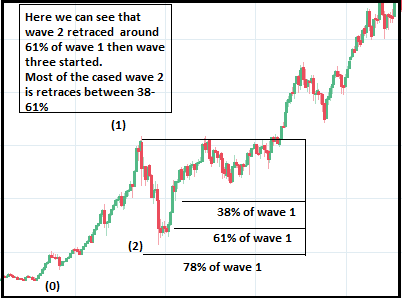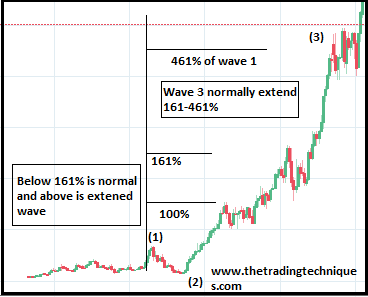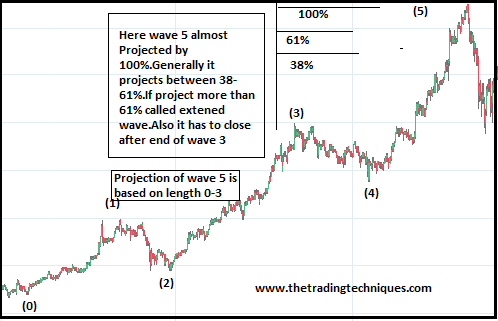Application of Fibonacci retracement in Elliott wave theory?
This the 6th article of our Elliott wave learning series which is a price action based technical analysis method. Here we shall discuss on Application of Fibonacci retracement and fibonacci projection in Elliott wave theory.
Application of Fibonacci retracement in Elliott wave theory
We have learned about Fibonacci ratio in previous articles. Now it’s the time to apply them in EWT. Also it is suggested to learn Fibonacci retracement before learning Fibonacci patterns for better understanding.
Projection is used for wave 3,5 and C after completion of a corrective wave. For the below mentioned cases projection is used.
- Wave 3 is projection of wave 1
- Wave 5 is projection of the whole move from 0 to 3
- Wave C is projection of wave A
Retracement is used for wave 2,4 and B after completion of an impulse. For the below mentioned cased retracement is used:
- Wave 2 is retracement of wave 1
- Wave 4 is retracement of wave 3
- Wave B is retracement of wave A
Now we shall discuss each retracement /projection in detail:
Fibonacci retracement Calculation for wave 1:
Wave 1 is the base for any wave cycle and it is the first wave in the cycle, so there is no base for calculation of projection or retracement for wave 1.
Fibonacci retracement Calculation for wave 2:
Wave 2 retraces wave 1 by 38%-61% most of the times. But sometimes it can be less than 38% also. Wave 2 at max can retrace up to 100% of wave 1 i.e. it cannot break below the starting point of wave 1.
Generally 61% is the best entry point for any trade because here risk reward is favorable. Stop loss point should be starting point of 1 and minimum target will be 100% projection of wave 1.
[caption id=”attachment_360" align=”aligncenter” width=”402"]

Fibonacci retracement for wave 2[/caption]
Fibonacci Projection for Wave 3
[caption id=”attachment_361" align=”aligncenter” width=”368"]

Fibonacci Projection for Wave 3[/caption]
Minimum projection for wave 3 is 100% of wave 1. If wave three projects 100–161% then it is called normal wave 3 and if project more than 161% then it is called extended wave 3.
Normally wave three project 161–461%.It may be even more. This is the reason it is said that if you can catch wave 3 you will be rich.
Fibonacci retracement Calculation for wave 4:
[caption id=”attachment_362" align=”aligncenter” width=”439"]

Fibonacci retracement Calculation for wave 4[/caption]
Wave 4 retraces wave 3 by 23–38% normally. It sometime may be smaller than 23% and may be even smaller than 10%.
For small no of cases it retraces more than 38% , but it can retrace maximum up to end point of wave 1 . That means wave 4 cannot overlap wave 1(exception is Diagonal Triangles that will be explained later.)
Fibonacci Projection of wave 5:
- Projection of wave 5 is calculated based on whole length from 0 to end of 3. Wave 5 retraces minimum 38% of length of 0 to 3 and must complete after the end of 3. These two conditions are minimum requirements for wave 5.
- Generally wave 5 projects up to 38–61%, if it is greater than 61% then called extended wave.
- Wave 5 rarely extends more than 100–123%.
- [caption id=”attachment_363" align=”aligncenter” width=”498"]

- Fibonacci projection for wave 5[/caption]
Also read other topic covered under our free Elliott wave theory course :
- Concept of Elliot Wave Theory- Wave cycle
- Rules of Elliott wave Theory
- Fibonacci Ratio.
- Component of EWT
- Elliott Wave Personality
- Application of fib ratio in EWT
- Elliot wave patterns
- Different Patterns in EWT
- Impulse
- Leading Diagonal Triangle
- Ending Diagonal Triangle
- Simple Zigzag correction
- 3–3–5 Flat Correction
- Irregular Correction
- Formation of Irregular Correction
- Complex correction.
- Extended and failure wave
- Rules of alteration
- Combining patterns with Fibonacci ratio
- Importance of 38% retracement ,alternate wave count and reflex point.
- Time frame to use in Elliot wave analysis
- Identifying multibagger stock
- Practical use of the theory